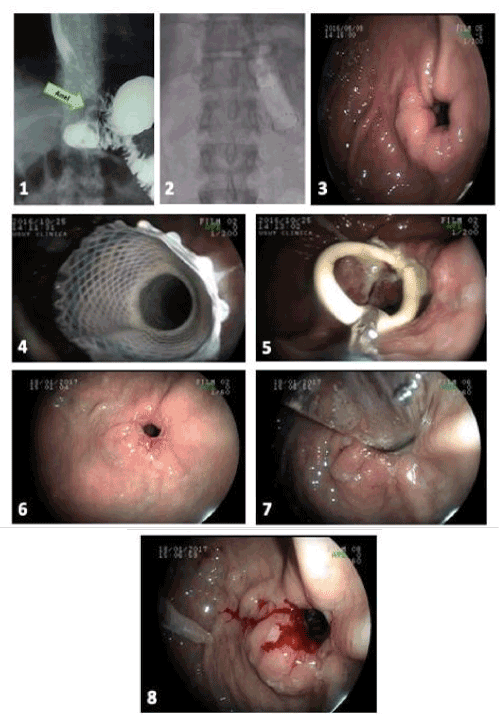The silicone ring of Roux-en-Y Gastric Bypass can determine benefits in long-term weight loss [1], but complications occur in about 1% of cases [2]. For example, ring slip, which consists of distal displacement, outside the gastric pouch towards the jejunum, causes secondary compression and symptoms such as post-eating vomiting, food intolerance and even malnutrition [3,4]. The technique for removing the ring by surgery is more frequently used [5], but in this case-report we will describe an endoscopic approach of removal [6,7]. The objective of this case report is to demonstrate the endoscopic technique of gastric ring removal through the use of self-expanding plastic prosthesis.
A 40-year-old female patient underwent Roux-en-Y Gastric Bypass (BGYR) in 2002 with gastric ring placement and pre-operative weight of 125 kg (BMI = 51.3 kg / m²). Two years post surgery she presented with daily post-meal vomiting and intolerance to solid foods. During this period, the patient reached a minimum weight of 68kg (BMI of 27.9kg / m²) and presented weight regain to 88kg (current BMI of 36kg / m²). A High Digestitive Endoscopy (HDE) and duodenum stomach and esophagus serigraph (DSES) was performed and evidenced findings compatible to the hypothesis of partial slip of the gastric ring (Figure 1).

Figure 1:
- Contrast radiological study showing the ring on the gastrojejunal anastomosis;
- Radioscopy of the prosthesis positioned under the ring;
- Endoscopic view of the ring slid over the anastomosis;
- Endoscopic image of the prosthesis;
- Removal of the migrated ring into the light;
- Endoscopic control after ring removal, subastasis of anastomosis;
- 7. Dilation of the hydrostatic balloon;
- Final result after dilation.
The procedure was performed in hospital, lasted about 25 minutes and was done under general anesthesia. While in supine position, the patient was submitted to HDE and the metallic guide wire was positioned at 15cm distal to the gastrojejunal anastomosis. Through this, a self-expanding plastic prosthesis (Polyflex® 18x23x90mm; Boston Scientific, Natick, MA, USA) was introduced and positioned. Then, radio and endoscopic control were performed to confirm the position of the ring on the prosthesis. After the procedure, the patient remained on a complete liquid diet and was accompanied by a nutritionist.
Two weeks later, the prosthesis was removed endoscopically on an outpatient basis using a foreign body forceps. In the endoscopic view the total migration of the ring to the gastric lumen was visualized and it was removed by the oral endoscope. After the removal of the prosthesis, the patient evolved with partial improvement of the symptoms and it was verified the cicatricial subestenosis of the stomach portion. Two endoscopic dilations were performed with a hydrostatic balloon (QD-12X8, 80x12mm, Cook Medical, Cook Medical Inc, Winston Salem, NC, USA) with an interval of four weeks.
The patient progressed with complete symptom improvement and currently has no food restrictions related to food consistency. She was inserted in a program of food reeducation and passes well without intercurrences.
- Awad W, Garay A, Martinez C (2012) Ten years experience of banded gastric bypass: does it make a difference? Obes Surg 22: 271-278. [Crossref]
- Arasaki CH, Del Grande JC, Yanagita ET, Alves AK, Oliveira DR (2005) Incidence of regurgitation after the banded gastric bypass. Obes Surg 15: 1408-1417. [Crossref]
- Blero D, Eisendrath P, Vandermeeren A, Closset J, Mehdi A, et al. (2010) Endoscopic removal of dysfunctioning bands or rings after restrictive bariatric procedures. Gastrointest Endosc 71: 468-474. [Crossref]
- Valezi AC, Mali Junior J, de Menezes MA, de Brito EM, de Souza SA (2010) Weight loss outcome after silastic ring Roux-en-Y gastric bypass: 8 years of follow-up. Obes Surg 20: 1491-1495. [Crossref]
- Taddeucci RJ, Madan AK, Ternovits CA, Tichansky DS (2007) Laparoscopic re-operations for band removal after open banded gastric bypass. Obes Surg 17: 35-38. [Crossref]
- Hookey LC, Mehdi A, Le Moine O, Devière J (2005) Removal of a gastroplasty ring. Gastrointest Endosc 61: 594. [Crossref]
- Wilson TD, Miller N, Brown N, Snyder BE, Wilson EB (2013) Stent induced gastric wall erosion and endoscopic retrieval of nonadjustable gastric band: a new technique. Surg Endosc 27: 1617-1621. [Crossref]

